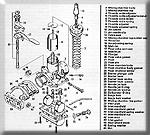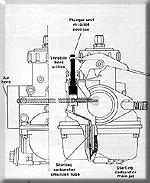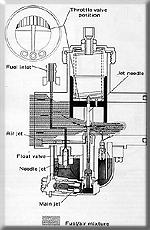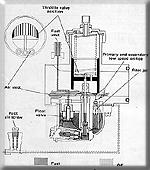
Common as pig tracks, the good old round-slide Mikuni carb came on two
generations of dirt bikes.
|
A huge number of vintage
bikes come equipped with the good old round-slide Mikuni carb. In fact, just about every
Japanese bike from the 60s and 70s came with this mixer.
All things considered, the round-slide
Mikuni is an excellent carb, with a wide range of tuning capabilities. You can also find
jets and parts easily.
Still, many Mikuni-equipped dirt bikes
are running poorly, or are hard to start. A basic understanding of this carb will make
life a whole lot easier. And, if nothing else, making your vintage bike easier to start
and less prone to fouling plugs, will be worth the time to learn a few things.
WARM VERSUS COLD
When an engine is warmed up, it
usually re-starts easily.. Just open the throttle part way, boot it, and it starts.
However, when it's cold, the problem is that gasoline drawn into the engine tends to
remain in liquid form and not evaporate.
To create a combustible mixture in the
cylinder, some of the fuel has to evaporate and make a vapor. The vapor mixes with the
air, and when the ratios are correct, it can be ignited with ignition spark.
If there is not enough fuel, or too
much, you can kick until you're blue in the face, and the bike may not start. When
only a little bit of the fuel is vaporizing, you have to put in a great, excessive amount
of liquid fuel just to get enough of it vaporized to start the engine.
That's called
choking or priming the engine.
PRIMING THE BEAST
Some carbs, such as Bings or Amals,
have a little plunger on the side, called a tickler. When you push down on it, it reaches
into the float bowl and forces the float downward. This opens up the float valve and lets
gasoline flow into the bowl until you release the tickler button. This causes the fuel
level in the bowl to be too high for normal operation, but just fine for priming the
engine.
When you kick over engine, the airflow
through the venturi passage can pick up the extra gasoline, because the fuel level is
higher in the bowl. With the extra fuel, it can be sucked up, and out into, the airstream
more easily.

Actual exploded view of a round slide Mikuni carb. Even a ham-fisted mechanic can
take one apart and put it back together. Lo Res | Hi
Res
|
If your mixture is way
too rich, or you prime it too much, you just might foul a spark plug, especially with a
two-stroke. You can spot a fouled plug by the plug tip wet with fuel, and it
doesn't
spark.
You'll have to pull out the wet
plug and replace it with a dry one, properly gapped. Kick it once or twice without priming
any more, and it should start.
If you don't have a spare plug
handy, open the throttle fully and kick it a few times without priming it any more. This
lets in a lot of air and not much gasoline, and with any luck, it'll dry out in there
and you can finally get it started.
Most Japanese carburetors (Mikunis and
Keihins) and some models of the European brands, provide starting mixture enrichment in a
better way. They have a little lever on the carb body that provides a special starting
circuit.
Here's how it works:
With the engine running and put
your palm over the carb air inlet. You will feel the rush of air through the carb and into
the engine and you will notice that it tries to pull your hand firmly against the air
inlet opening. The closer you get your hand to the opening, the more the air is blocked by
your hand and the more suction there is. If you allow your hand to close off the opening
completely, the engine will quit running.
What this proves is that any
obstruction in the air passage of an engine that is rotating, will create a large suction
(or vacuum) between the obstruction and the engine.
Carburetor designers make use of that
suction to cause starting enrichment. One way is to use a separate little carburetor built
right into the main body, called a starting carburetor. It has an air inlet on the side of
the bell mouth at the front of the carb. From the starting air inlet, air flows through a
little passage in the body of the carburetor and passes by its own private fuel jet
leading from the fuel bowl. There, the airflow joins with fuel flow through the jet, and
both air and fuel flow through a passage toward the outlet of the carb at a point behind
the throttle slide.
The primer control lever is called the
choke, and when it's closed, the starting circuit is shut off. Sometimes, when the
temperature is very cold, you may have to use the choke lever for a few minutes while the
bike warms up. However, if you leave it on too long, you might end up with that fouled
plug we talked about earlier.
DON'T OPEN THAT THROTTLE WHEN
USING THE CHOKE!
Air flowing into the starting
carburetor makes fuel come out of the bowl to join the airflow, and this is caused by the
high vacuum, or suction, because you are cranking the engine. The piston is moving up and
down gasping for air, but it can't get very much, so vacuum is high.
What makes high vacuum behind the
throttle slide, is the fact that you are cranking the engine with the THROTTLE SLIDE
CLOSED. Leave the throttle completely closed until the engine starts. If you
can't resist opening the throttle with a spastic reaction every time your kicking
foot moves down, try putting your right thumb in your mouth.
If you insist on opening the throttle,
the vacuum behind it disappears and the starting carb will not work. Most of the hard
starting of Mikuni-equipped bikes is caused by this right-hand syndrome.
CHOKE MECHANISM

Typical lever-type choke; it's used for cold starting.
|
This is different than a
choke primer, in that a choke mechanism is a mechanical slide that lives up in the top of
the carb, and can be moved down into the main air passage in front of the carb slide.
Also, many chokes have a little trap door held closed by a spring. When
you're
cranking the engine with the choke closed, the door springs open just the right amount to
allow the necessary amount of air to come in.
There aren't any special fuel or
air passages with a choke of this type. When the choke plate is lowered into the air path,
fuel will come up out of the needle jet and enrich the mixture for starting. The position
of the throttle slide doesn't make much difference, because this system
doesn't
rely on a closed throttle slide to create high vacuum behind it.
AFTER THE BIKE IS STARTED
Once you get the thing lit off, the
bike now has to idle. The idle system on all conventional carburetors is exactly like the
starting carb, except it doesn't have a lever to turn it on and off. It works anytime
the throttle slide is closed (or nearly closed) and there is sufficient vacuum behind the
slide to pull idle mixture out through a small hole, which is also just behind the slide
- on the bottom of the air passage, usually.
Sometimes there are two holes to
deliver idle mixture, one just behind the back edge of the throttle slide and one just
under it. As the throttle slide is lifted, up, the one under it also starts discharging
mixture. The one under it is often called a bypass orifice. Sometimes the two are called
primary and secondary idle discharge orifices
The idle circuit is from an air hole in
the mouth of the carb, past a screw that sticks into the air passage, to adjust the amount
of airflow, past a special jet that draws fuel from the float bowl, and then through the
discharge hole - or holes - in the main bore of the carb.
The screw that sticks into the idle air
passage is called the pilot air screw, or the idle air screw. The jet that limits fuel
flow into the idle circuit is usually called the pilot jet or idle jet. Sometimes the air
screw and associated jet are called slow-running screw and jet.
The idle mixture is controlled by three
adjustments:
A throttle stop screw which goes into
the side of the carb right beside the throttle slide. It limits how much the slide can
close. The slide is never fully closed, so some air ducks under it and flows into the
engine when you think the throttle is closed.
You adjust the throttle stop screw for
the idle speed you want and the idle air screw for mixture strength at that idle speed.
These two controls interact and a good adjustment procedure is as follows:

When the slide is raised, fuel flow from the idle circuit decreases.
|
Turn the idle speed up a
little higher than you want it to be, using the throttle stop screw. Now turn the idle air
or pilot air screw inwards until the engine runs poorly.
Usually turning this screw inwards
makes the idle mixture richer, and when the engine begins to stumble it's because of
a too-rich mixture. Stop turning the screw inward when the engine acts like it is about to
quit running. Start backing it out and count half-turns of the screw as you do it.
The engine should speed up as you back
the idle air screw out and then start slowing down as you continue backing it out. When it
runs poorly, stop backing it out. Count the number of half-turns you made while backing
the screw out from run-poorly to run-poorly. Set the idle air screw halfway between these
extremes, or at a nearby setting where the engine runs fastest.
Back out the throttle stop screw to
reduce the idle speed to what you want. Then re-check the idle air screw adjustment and
reset to the place where the engine idles fastest or smoothest.
DIALING IN THE PILOT JET
The pilot or idle jet should be the
right size to allow you to perform the idle adjustment. If you can't get it to idle
properly, you might have the wrong size jet. Here's how to tell: let's say
you're turning the idle air screw in and it should be making the mixture too rich.
The engine speed keeps increasing until finally you have the screw turned all the way in,
and it's running best right there. By the time you get the screw turned all the way
in, the mixture should have been much too rich. So you can figure that the idle jet is too
small, and needs the next size larger.
If you back out the idle air screw and
the engine just keeps running faster and faster until finally the screw falls out of the
carb, it tells you the idle jet is too big and is letting too much fuel through. Install a
smaller (leaner) one.
Some manuals tell you to turn the idle
air screw all the way in and then back it out a specified number of turns for a good idle.
Usually this is around one or two turns out. If you can't get a good idle with this
setting, or close to it, the idle jet is the wrong size.
THE IDLE SYSTEM IS CRITICAL TO
OVERALL PERFORMANCE
The idle system is part of the
carb's entire operating system. By opening the throttle slide, the main system is
supposed to take over and the idle system is supposed to decrease delivery of mixture. The
transition between these two systems is critical to good performance when you first crack
the throttle, and on up to about one-eighth open.

At idle and slightly above idle, the fuel flow is regulated by the pilot jet and the air
screw.
|
There are two factors
that aid transition from the idle system to the main system. One is the setting of the
idle system itself. Some mechanics set the idle as described and then test throttle
response by whacking open the throttle. They try slightly different idle air screw
settings to see what gives the best throttle response off idle.
THROTTLE SLIDES
The part that affects throttle response
coming off idle, is the throttle slide cutaway. Most slides have a V-shaped section
removed from the bottom of the throttle slide, with the open end of the V facing toward
the mouth of the carb. The amount of cutaway is indicated by a number stamped on the
slide. A higher number means more cutaway.
More cutaway makes the mixture lean.
Less cutaway makes it richer. If your engine hesitates when you open the throttle part
way, and seems to hesitate briefly before giving you a surge of power, the off-idle
mixture may be too lean. Try a throttle slide with less cutaway.
If it stumbles when you crack the
throttle wide-open, it isn't throttle slide cutaway. Why? Because when the slide is
quickly pulled up, cutaway doesn't have a chance to affect the transition. |